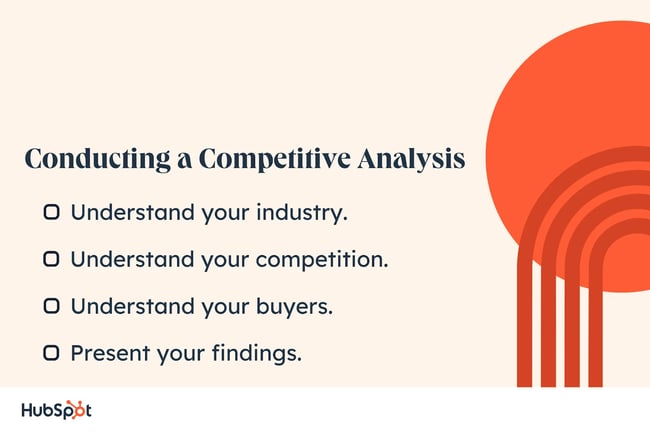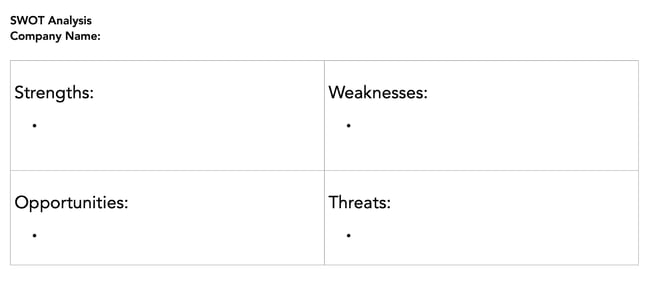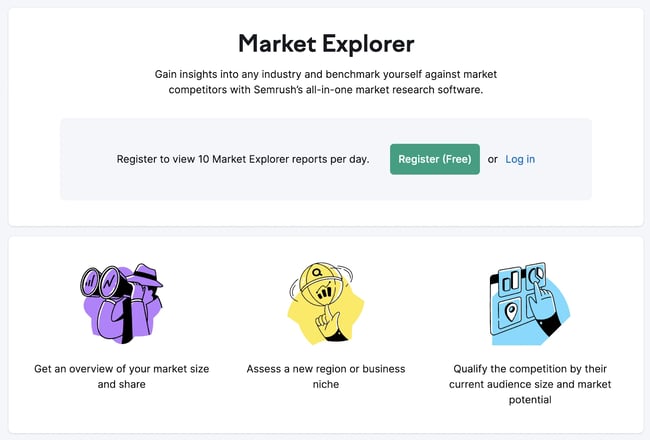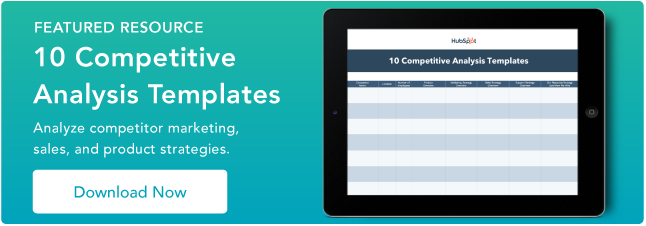
Many marketers don’t take advantage of competitor audits, so we have to ask: When was the last time you performed a competitor analysis for your brand? If it’s been a while or you aren’t sure how to do a competitor analysis, we can help you through the process.
Too often, a competitor analysis is reserved for the early days of a company or the launch of a new product. But knowing how your competitors are positioning their products is key to ensuring that your content remains relevant.
In this post, you’ll learn the benefits of revisiting your competitor analysis, as well as tips to get it right.
Table of Contents
- What is a competitor analysis?
- Benefits of Competitor Analysis
- How to Conduct a Competitive Analysis
- Competitive Analysis Template
- Competitive Analysis Example
What is a competitor analysis?
At its most basic level, a competitor analysis identifies your peers in the industry and then takes a deeper look at what they are doing. You can see how you’re doing in comparison and gain insights about what you can be doing better. It’s a smart strategy for identifying trends and pinpointing opportunities to become more competitive in your niche.
Benefits of Competitor Analysis
The first and most obvious benefit of a competitor analysis is understanding your position in the market. You can understand where your peers are excelling whether or not you are keeping up.
If the honest answer is that you’re not — that’s okay! Now you know. After the analysis, you can begin an open conversation about how to improve.
1. You can grow your business.
Marketers and competitive research professionals agree that staying on top of your competitor leads to more success. HubSpot research found 90% of marketers report positive impacts on their business from using competitive research as part of their strategy.
2. You’ll see more revenue.
The benefits of competitor analysis can be financial as well. In fact, 68% of marketers see positive revenue impacts with a weekly evaluation of competitive research.
Consistency here is key. Competitor analysis has proven to be most valuable when firms ditch the inconsistent drop-ins and incorporate the practice into their scheduled marketing operations.
3. You’ll find new opportunities.
A thorough analysis of your competition could reveal opportunities — like gaps in your competitor’s offerings. Identifying missing functionality is an opportunity to meet buyer demands that your rivals overlook.
4. Your business can maintain relevance.
With a competitor analysis, you can note what your peers are doing really well. You can then emulate their successful strategies to catch the attention of more buyers.
How to Conduct a Competitive Analysis
So, how do you start? Follow the steps below to evaluate your competitor, learn from your buyers, and then curate your information.
1. Understand your industry.
The first step is to complete Porter’s Five Forces analysis. It’s a way of determining the level of competitive rivalry in your industry. This framework prompts you to start thinking about how to be more competitive within your market — or if you are more or less likely to find success in a new market.
You’ll evaluate the threat of new entrants, the strength of buyer power, the threat of substitution, and how supplier power affects your ability to be competitive in the niche you want to occupy.
2. Understand your competition.
Doing a SWOT analysis (strengths, weaknesses, opportunities, and threats) on your competitor is the next step. This is invaluable research specifically focused on one rival at a time, and it’s where you’ll start looking for trends in their content strategy and investigating their SEO results.
Proactively seek these out so you can start creating solutions to be more competitive.
3. Understand your buyers.
There are various ways to conduct surveys and perform focus groups, but at the heart of it is getting information straight from the source. Your buyers understand their needs, wants, and what impedes them. It is imperative to consult them.
4. Present your findings.
There’s a reason that Scientist and Science Communicator are different job titles. You can do all the research in the world, but it won’t make an impact until the people in the trenches understand and can make use of the information.
PowerPoint is still very prevalent in big business, so putting forward a focused and concise slide presentation with infographics is the way to go.
Our Market Research Kit includes a resource for getting started with data visualization for marketers.
Competitive Analysis Templates
So you’re ready to conduct a competitive analysis. These templates can help you get started.
1. HubSpot’s Marketing Strategy Kit
Our Marketing Strategy Kit includes resources for getting started with your competitive analysis, including Porter’s five forces analysis and a SWOT analysis template.
You’ll also find guidance on conducting fact-finding surveys and focus groups, creating buyer personas, and a plug-and-play PowerPoint presentation to help you share your findings.
This is the empty SWOT template we provide inside the Market Research Kit. Here you can gather your findings and keep them organized on one sheet. This chart can easily be plugged into the provided PowerPoint presentation, making sharing findings a breeze.
2. MECLABS
The MECLABS Institute has a series of competitive analysis documents. If you’re looking to understand the forces shaping your industry, MECLABS’ resources can help you compile the research.
All of the charts that you complete can easily be turned into slides. The visuals make your analysis easy to understand.
3. Semrush Market Explorer
You may feel overwhelmed about starting your research from scratch. Semrush can help. Before you start surveying the marketplace on foot, you can assess your competition entirely online.
Semrush offers a free trial that includes market research tools. Here you can see the size of your industry, available niches for your business to fill, and your competitors’ market potential.
You’ll also see how well your business can position itself with online search engines.
Competitive Analysis Example: The Coffee Shop
Let’s say you want to start a new coffee shop in Boston that specializes in making Asian-inspired lattes. To see the viability of your new business, you would start with the following competitive analysis.
Porter’s Five Forces Analysis
Let’s start by determining the level of competitive rivalry for your business. We’ll explore how the business compares to other coffee shops using Porter’s Five Forces.
1. Competition in the Industry
- Boston has a large number of coffee shops, including large chains. Your business will need to compete with large players like Dunkin’ and Starbucks.
- Coffee companies Jaho and Ogawa also serve Asian-inspired drinks. You’ll want to make sure that your shop is in a different neighborhood to avoid competition.
- While many Asian restaurants sell coffee, they also sell full meals. Your coffee shop offers a different type of experience, so you are less likely to compete with these establishments.
2. Potential of New Entrants
- As a drink company, you’re not just competing with coffee shops. Boston’s budding boba scene may distract from your business.
3. Power of Suppliers
- If you’re using imported ingredients at your shop, you’ll rely on suppliers to run your business. How reliable is your supplier? Do you have a backup if your primary supplier cannot complete an order?
- Instead of having a logo custom printed on your cups, you have a stamp that you can use on your items. You can then use any supplier for cups and sleeves, allowing you to secure the best price.
4. Power of Customers
- Let’s say your storefront is near a local college campus. You’ll have a continuous flow of customers as students come in and out to study.
- However, these customers have tight budgets. You may need to lower your prices to keep these college students coming back multiple times a week, instead of once a month.
5. Threat of Substitute Products
- Coffee has gotten more expensive in recent years. Customers may be more likely to make their own coffee at home.
- Larger players have rewards apps, which offer perks like free drinks. You may lose customers to these players that offer free products.
Running a SWOT Analysis
A SWOT analysis can help you better position your brand in your market. For our coffee shop, let’s run a SWOT analysis on Jaho, another Asian-inspired coffee joint in Boston.
From this SWOT analysis, we learned the following:
- The location of your store will be beneficial for the business. Your coffee shop will be in a neighborhood that Jaho does not currently serve.
- Having a nice seating area will be essential. You want to make sure your shop has the same cozy atmosphere.
- Your menu should include flavors that Jaho does not. This allows your lattes to stand out.
Customer Research
To understand how your potential customers interact with coffee shops, you’ll need to conduct additional research.
Let’s say you’re not ready to interview potential customers. Instead, you can research the demographics of your area. That includes the age and income breakdowns of your customers.
You can also review the Yelp pages of nearby coffee shops. This will help you understand what makes for a good or bad experience in your customers’ eyes.
After this research has been compiled, it’s time to present your findings to your business partner. Then you can make sure your insights are incorporated into your business.
Making the Most of a Competitive Analysis
As you conduct competitor research, make sure you understand how findings affect your business. Pull in relevant statistics to show how you compare. This allows you to make the most of your research and helps demonstrate your points to stakeholders.
Creating as much context around your research as possible is the best way to make connections and find novel solutions. So get digging, get visual, and get more competitive!
![Download Now: 10 Competitive Analysis Templates [Free Templates]](https://no-cache.hubspot.com/cta/default/53/b3ec18aa-f4b2-45e9-851f-6d359263e671.png)







![SWOT Analysis: How To Do One [With Template & Examples]](https://blog.hubspot.com/hubfs/marketingplan_20.webp)



![5 Challenges Marketers Face in Understanding Audiences [New Data + Market Researcher Tips]](https://blog.hubspot.com/hubfs/challenges%20marketers%20face%20in%20understanding%20the%20customer%20.png)



![3 Ways Data Privacy Changes Benefit Marketers [New Data]](https://blog.hubspot.com/hubfs/how-data-privacy-benefits-marketers_1.webp)